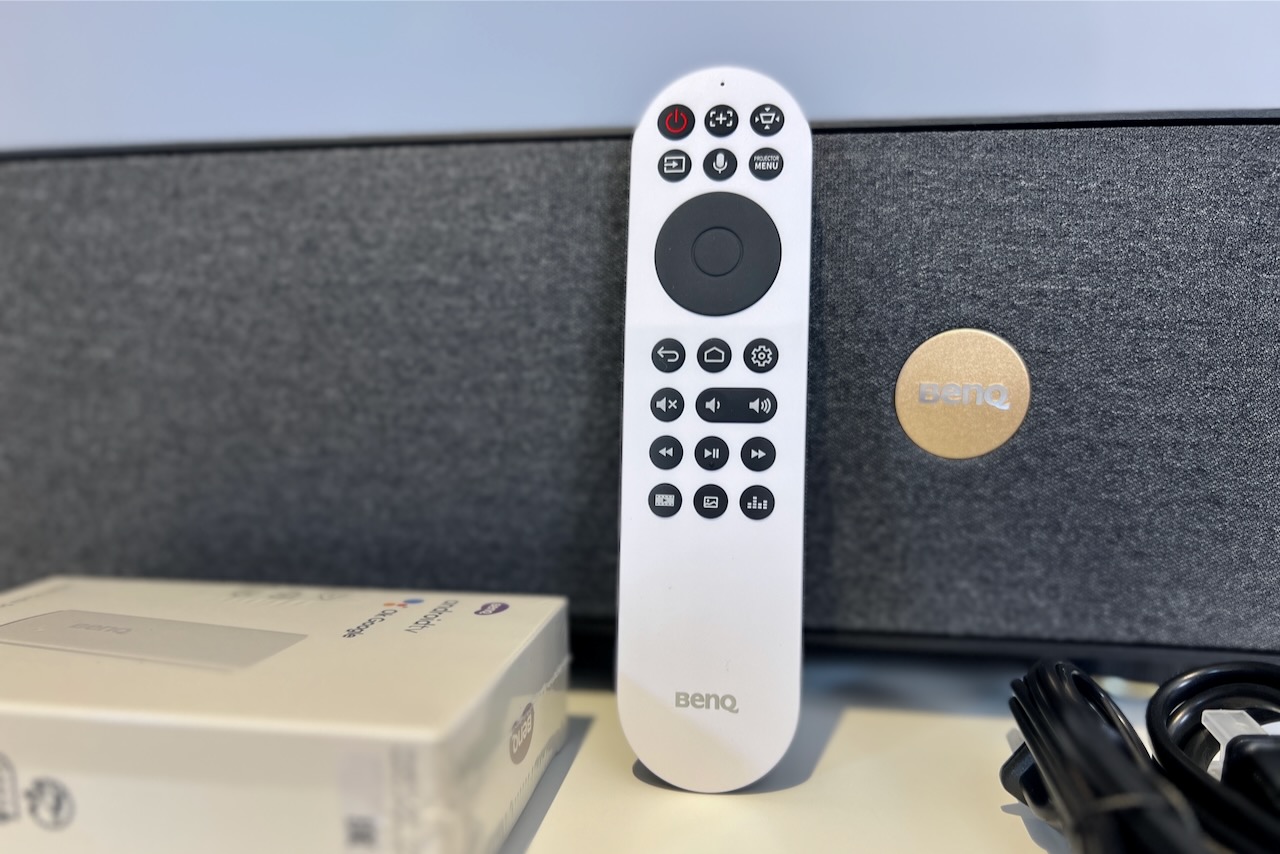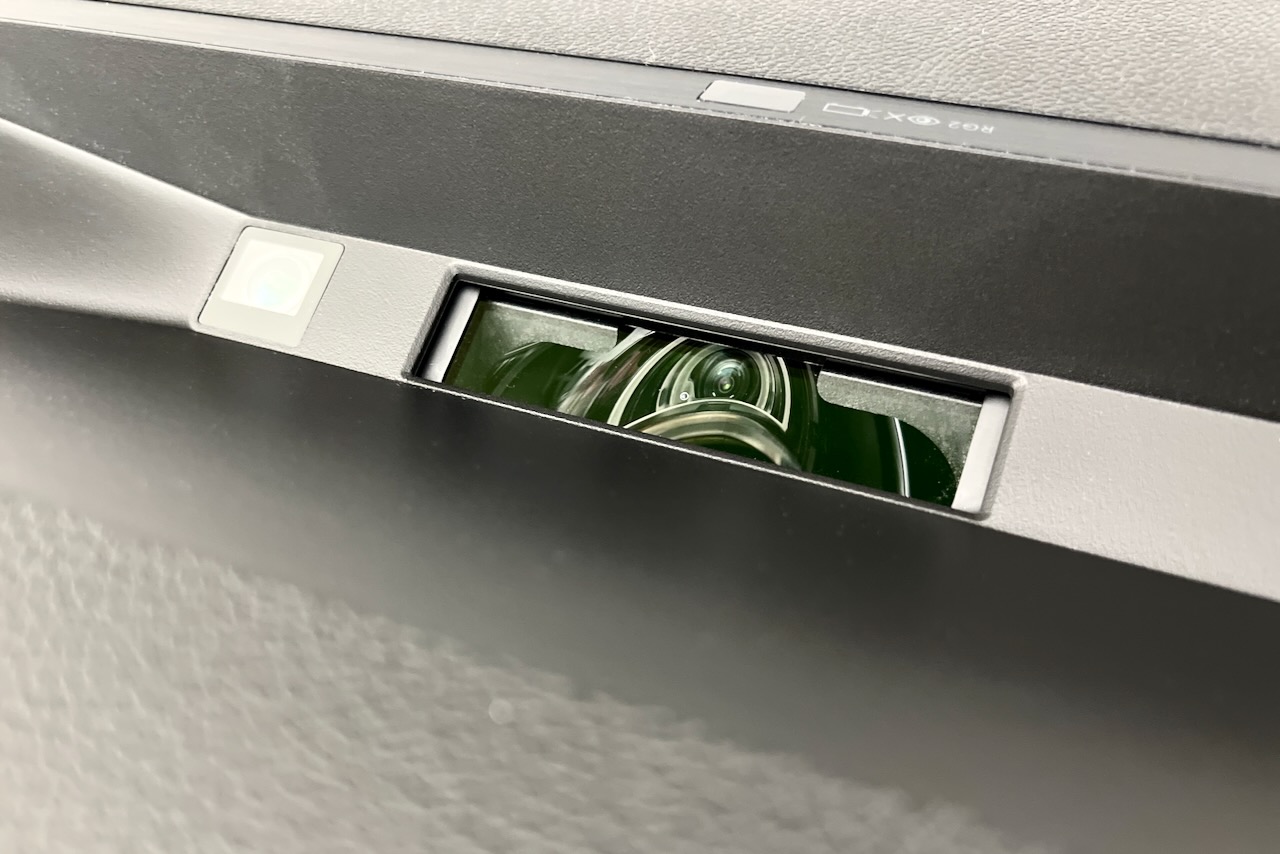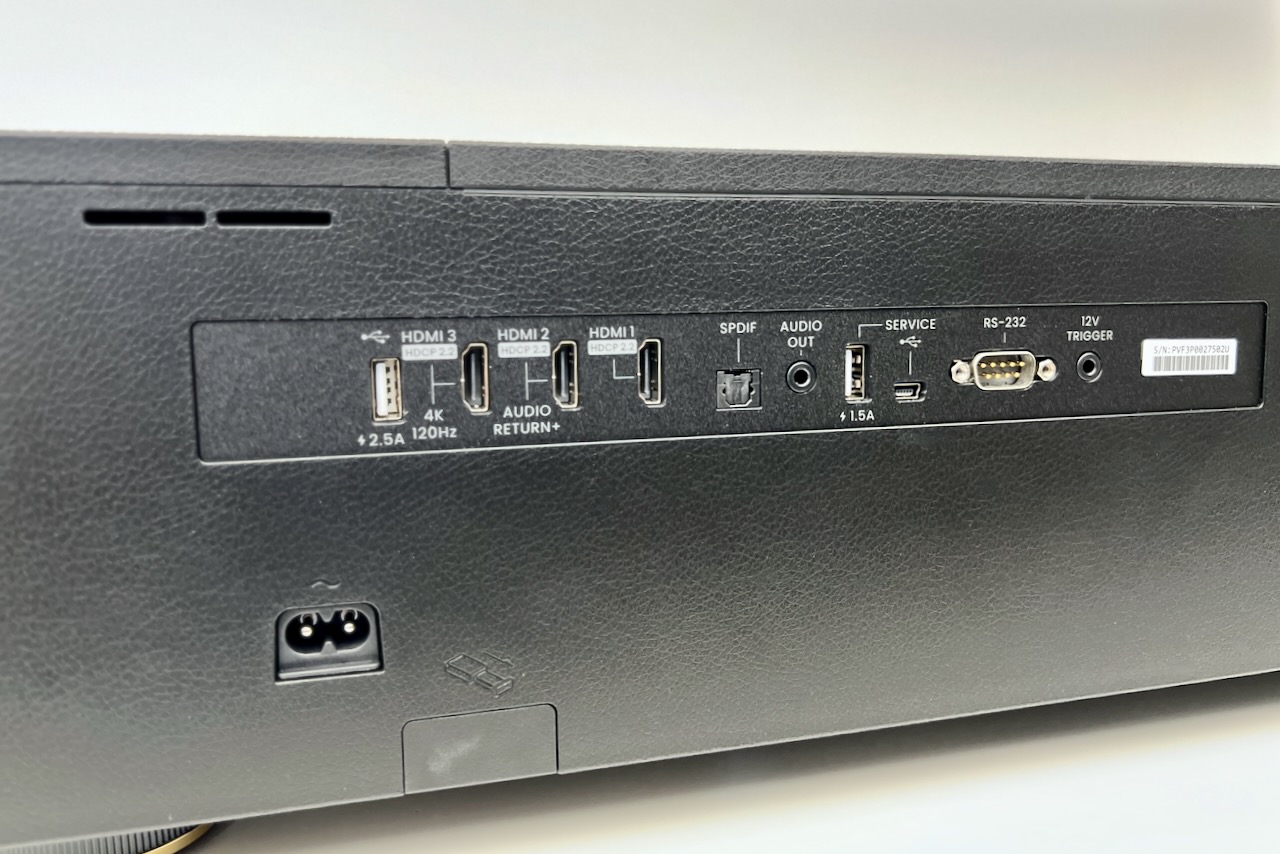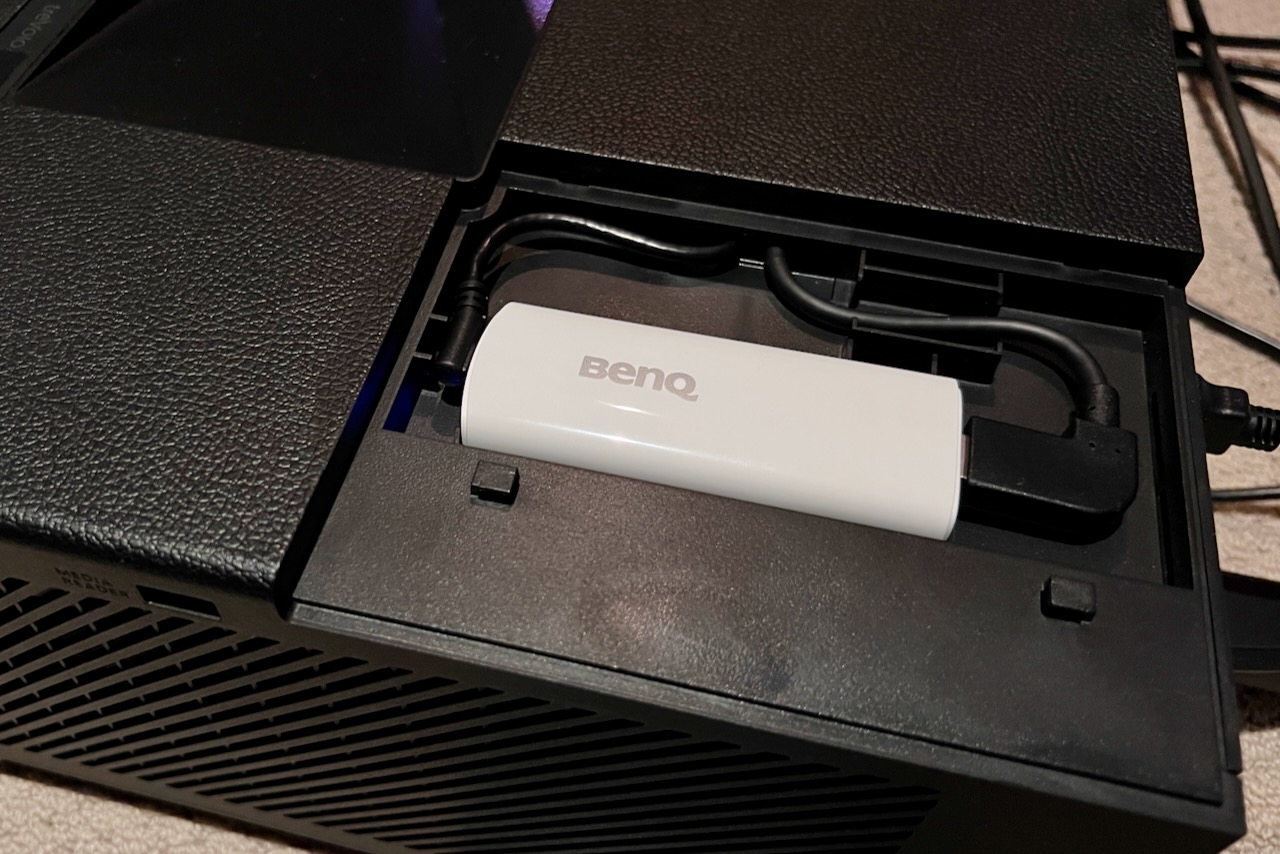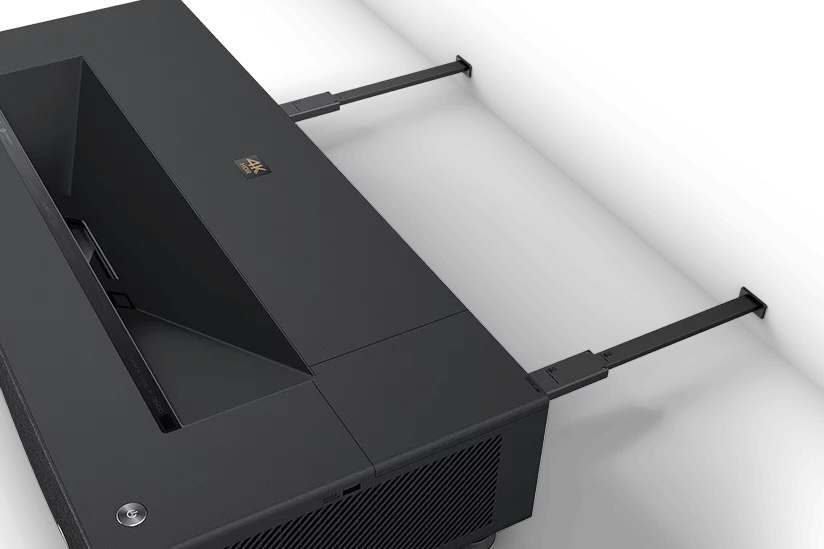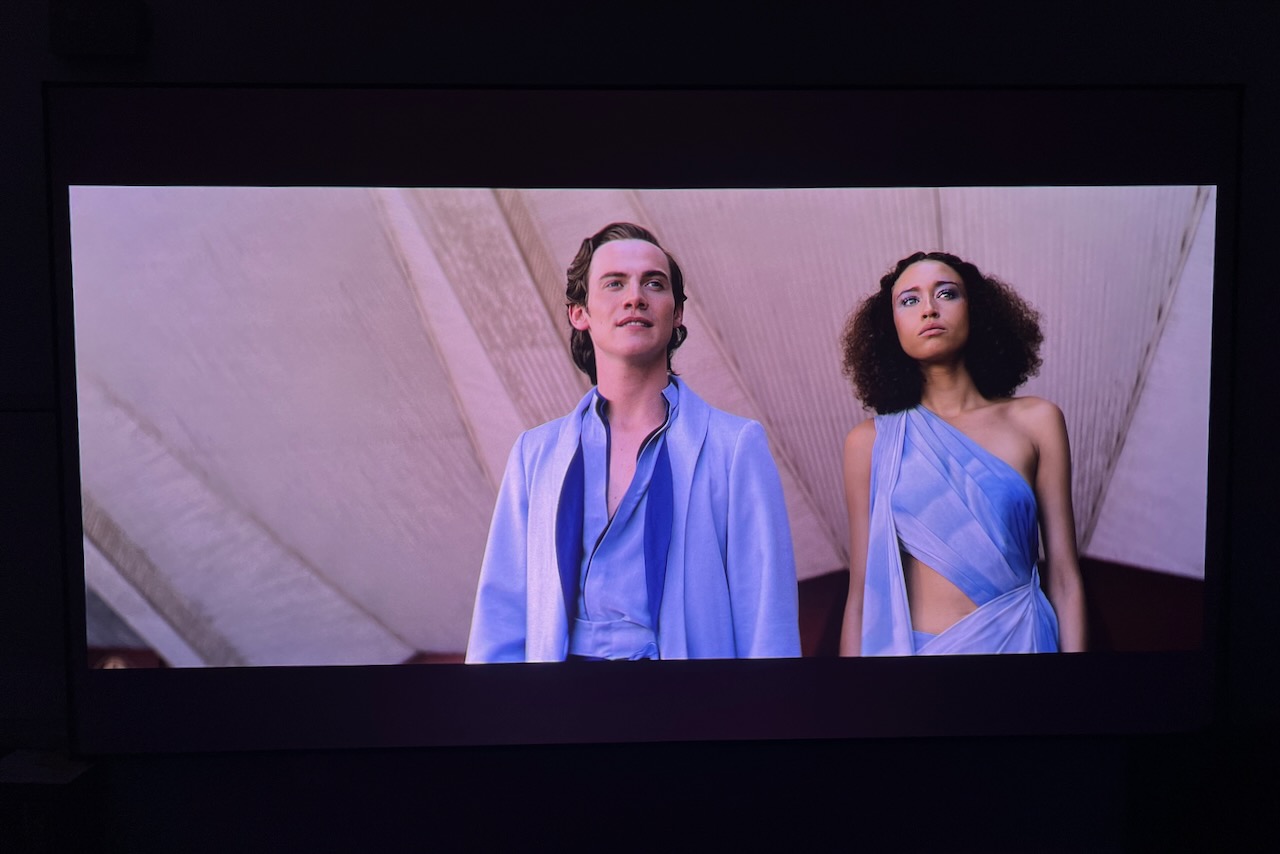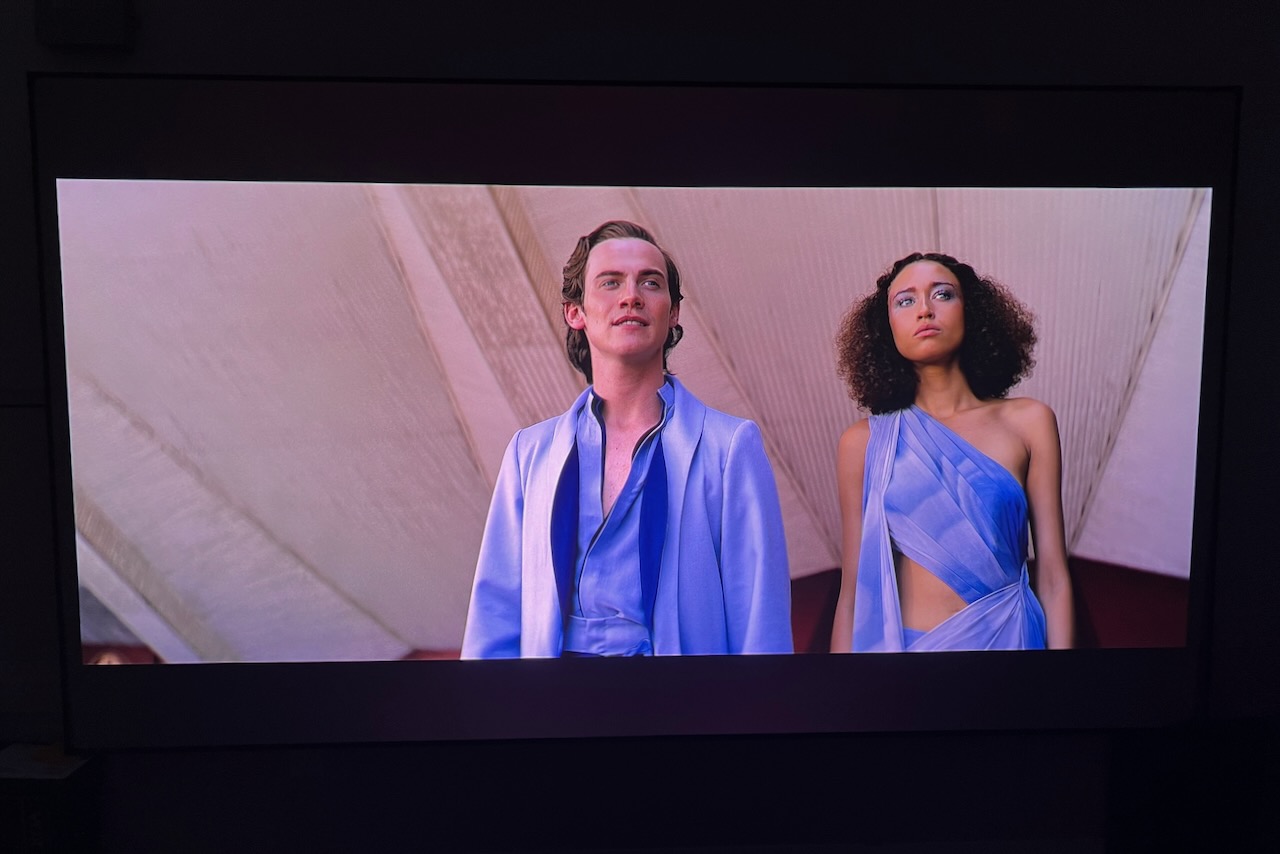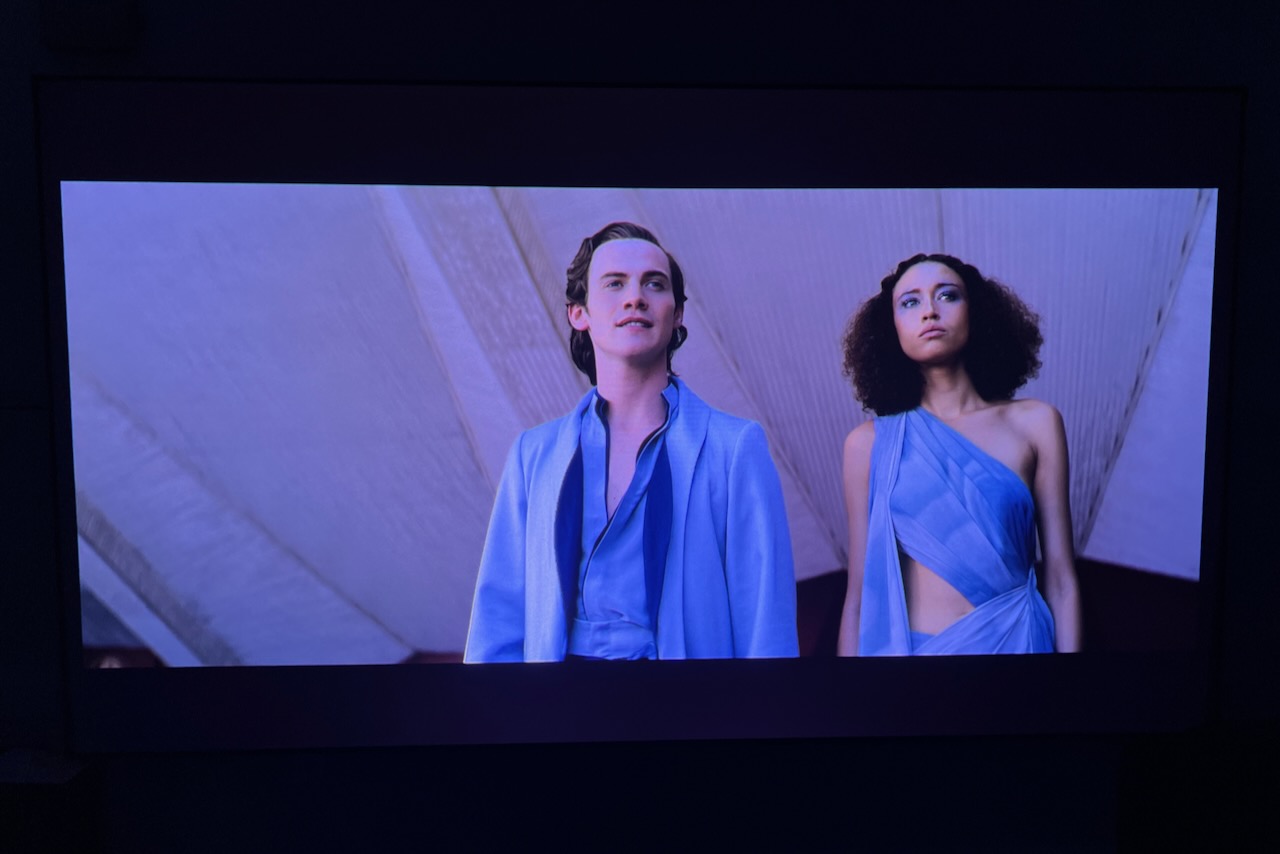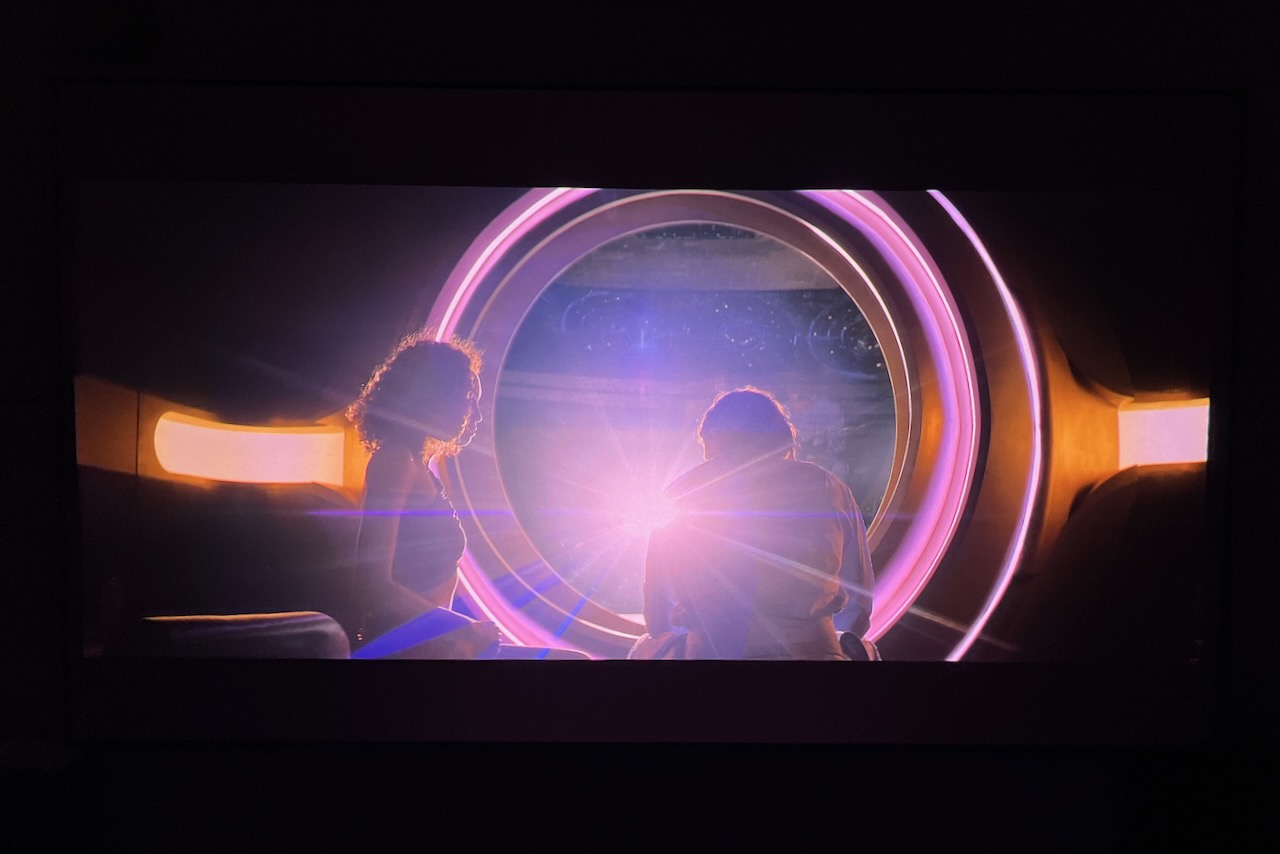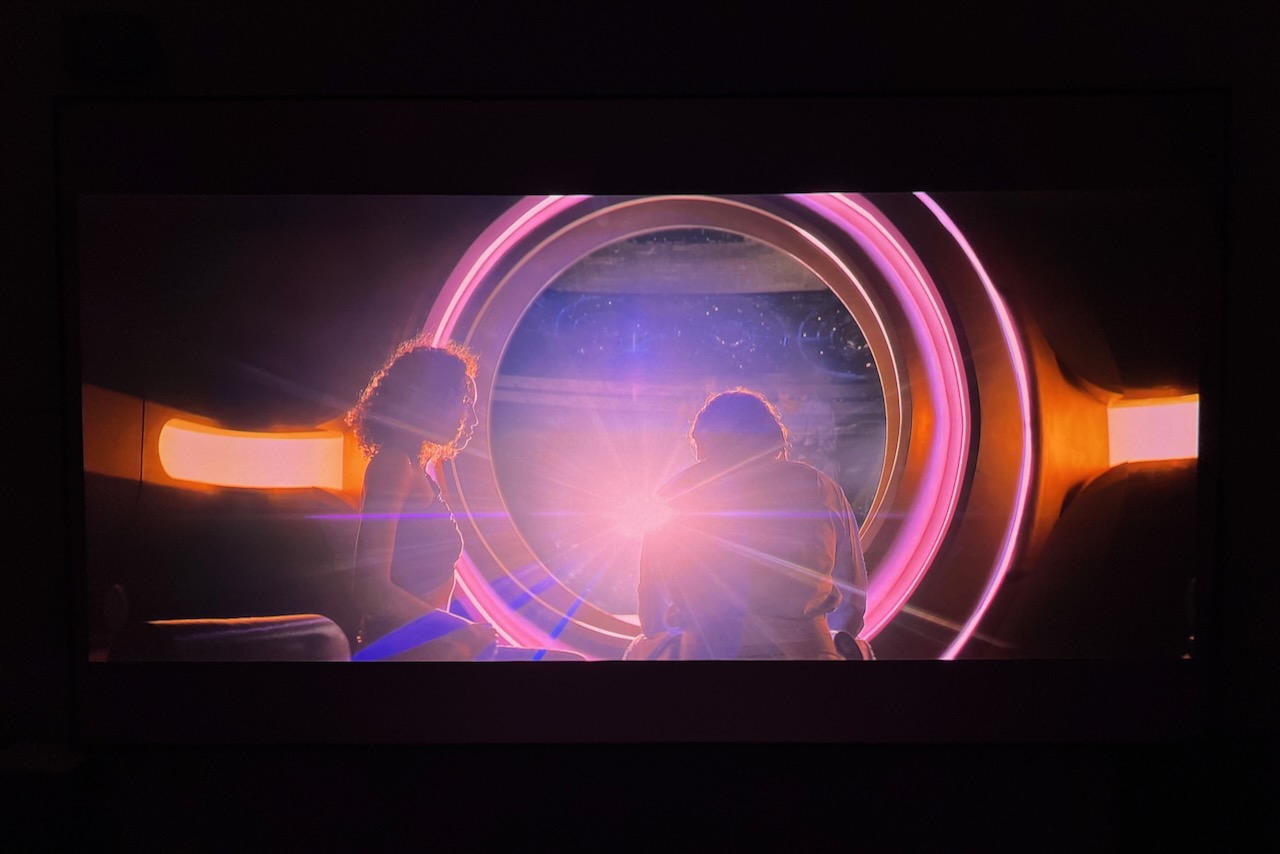“The BenQ V5000i UST projector is a beast in size and price, but its color and performance in bright rooms are excellent.”
- Vivid and rich color
- Excellent contrast, even in bright rooms
- Highly customizable
- Low input lag for gaming
- Comes with Android TV
- Built-in sound is good in a pinch
- Expensive
- 2,500 lumens is average for the price
- ALR screen is hard to assemble
Ultra short throw (UST) projectors are fast becoming the best way to bring that big, movie theater-like experience to your home. They may be pricier than standard-throw projectors, but what you can get for that extra money is a machine with excellent brightness and color that, most importantly, can throw an image of 100 inches or more from just a few inches away. This eliminates the need for complicated ceiling mounts and long speaker wire runs, as well as the need to rearrange your whole living room.
And while BenQ has been making some of the best projectors you can buy for years, the company has just recently started getting more serious about its UST offerings, launching only its second model, the V5000i, late last year. A beast of a projector (most USTs are, though), the V5000i is BenQ’s first 4K HDR projector to use an RGB triple-laser light source. And even though it may not be the brightest UST around, its 2,500-lumen output delivers surprising performance even in bright rooms, which is a feat in and of itself.
Color and contrast is spot-on out of the box, but it’s also insanely configurable for those who like to tweak. Gamers will also like the V5000i’s Auto Low Latency Mode (ALLM) with support for 4K 120Hz. And like other BenQ projector models, such as the excellent HT4550i we reviewed last year, it comes with an Android TV dongle to get you streaming fast.
The BenQ V5000i isn’t cheap though, at $3,500, and that’s not including the extra $400 for the ambient light rejecting (ALR) screen you should get to maximize the projector’s performance. BenQ was nice enough to send me one, and while I’ll get into it more below, let’s just say assembling it was almost the end of me.
However, once it was setup, configured, and running smoothly, my family and I spent nearly a month with the V5000i as our main “TV” in our living room. The 100-inch picture improved everything from movie nights to binge sessions of Love Island Australia. My 12-year-old also found the projector easy to use, and even the built-in 40-watt speakers sounded respectable.
Has all this made the hefty price tag easier to swallow? Let’s find out.
Features and design

Ultra short throw projectors are big, and the BenQ V500i is no exception. It measures two-and-a-half feet wide, 14-inches deep, and 6.4-inches high. It also weights nearly 30 pounds, so be careful lifting it into place. It’s big, yes, but its black exterior and contoured fabric speaker grille on the front make it look slimmer than you’d expect.
On top, you’ll find the projector’s lens and power button, but that’s it. Well, almost — beneath a removeable corner cover is a compartment for hiding away the Android TV dongle (more on this later). BenQ might have done better by offering a lens cover like the one that’s found it the V5000i’s older sibling, the single-laser V750i, to keep dust and pet hair at bay, but sadly it’s missing.
The bottom of the V5000i features four height-adjustable feet to fine-tune the projector’s positioning during setup, which is also helped along with some pretty ingenious retractable, telescopic rear rods that are slotted and measured to help you set the right distance from the wall or screen without the use of a measuring tape (although you probably should use one anyway).
The back of the V5000i is littered with connectivity options, including two HDMI 2.0 ports (one eARC), a single HDMI 2.1 port that will enable all that speedy gaming, two powered USB-A ports, an optical S/PDIF out, and a 3.5mm AUX output for audio.
Speaking of audio, this is one area where I was pleasantly surprised. Most projectors, UST or otherwise, that come with built-in audio tend to lean toward “you’d better get a soundbar with that” territory. But behind the V5000i’s grille sit two 5-watt tweeters and two 15-watt woofers, which delivered some eyebrow-raising sound. I’d still recommend a soundbar or proper home theater receiver, to be sure, but I found the built-in sound from the V5000i clear, reasonably full, and more than adequate in my small living room.
Aside from the sometimes finicky shifting and adjusting I had to do with the V5000i’s feet on my living room carpet (I set mine up on the floor as opposed to on top of a media unit), the V5000i has the same excellent auto screen fitting, alignment, and keystone features of many of BenQ’s other projectors, making setting, adjusting, and readjusting the image to fit the screen pretty easy. Of course, there’s also some pretty user-friendly manual alignment and corner-fitting features.
What wasn’t easy, however, was assembling the BenQ ALR Fresnel screen.
The ALR screen

While I’ve reviewed my fair share of projectors, a first for me with this review was doing it with the recommended ambient light rejecting, or ALR, screen that is paired with the BenQ V5000i. Is an ALR screen mandatory with a UST projector? No, it will work with any screen or even on a nice clean wall. But ALR screens are designed to absorb ambient light from windows or other sources in a room, as well as eliminate reflections and glare, to get the best possible image from the projector.
BenQ’s 100-inch SNS21 Fresnel screen is an $800 ALR screen that can be purchased with the V5000i for just $400, which is actually a steal when compared to other ALRs on the market. It’s a big, sturdy, and beautiful-looking screen with thick material, and it weighs roughly 30 pounds when assembled. BenQ even offers a free installation service for V5000i owners, which I highly recommend because putting it together myself was a challenge.
As a caveat, the SNS21’s assembly instructions were well laid out and the BenQ website has some excellent videos and resources to guide you through. In theory, it should have been straightforward and I have seen video reviews of this projector where the screen assembly looked like a piece of cake. Without getting too detailed, I don’t know if it was the unit I was sent or what, but while the frame assembly went smooth, the 20 or so spring-loaded screws that needed to be installed around its inside edge, which are meant to stretch the material perfectly flat, were nearly impossible to screw in by hand.
It also became clear to me that the white cotton gloves that come with the installation kit are less for safely handling the fragile screen or frame parts than they are for shielding your hands from the frame’s razor-sharp aluminum edges. I learned that the hard way.
After wrestling with it for a couple of hours, I’d almost given up when I decided to try a set of trigger clamps, my power drill, and some good old elbow grease to get the screws connected to their bolts.
Was it worth it? From a picture perspective, absolutely, and I’ll get into that below. But unless you plan on using BenQ’s free installation service, I would seriously consider looking at other options for ALR screens.
Picture, brightness, and HDR

The BenQ V5000i is an RGB triple laser projector rated at 2,500 ANSI lumens of brightness with support for HDR10, HDR10+, and HLG (but, sadly, no Dolby Vision). It also features local contrast enhancement that divides the picture into 1,000 zones that are analyzed on the fly and adjusted to optimize contrast.
The V5000i is capable of projecting a 4K UHD (3840 x 2160) image from 70 to 100 inches in size. BenQ’s FAQ states that you can go bigger, but you might see some blurring. For my review, I used it with the supplied 100-inch BenQ SNS21 ALR screen, which BenQ says has been specifically designed for the V5000i, and I found the picture to be really good in pretty much every room/lighting situation, for which the ALR screen can take much of the credit.
With the lights on or with daylight coming in from my small basement window, color and contrast faded to acceptable levels, but not nearly as much as with other projectors I’ve tested, such as the BenQ H4550i. This is really where I noticed the benefits of the ALR screen. Also as to be expected, in a dark room, the brightness, contrast, clarity, and color of the V5000i is exceptional. Its 2,500 lumens isn’t the highest on the market, but it’s comparable to others in the same price range, such as the Samsung Premiere LSP7T or the Hisense PX1-Pro.
The V5000i is capable of displaying 98% of the DCI-P3 color gamut (the mastering standard for the digital cinema industry), 95% of the BT.2020, and 100% of the Rec.709 standard, BenQ says. I didn’t measure it, but the colors were excellent out of the box.
Across the projector’s various picture modes, including a Filmmaker, Bright, Bright Cinema, and Living Room, as well as several modes for HDR content, the projector has a ton of manual calibration settings, including an advanced color temperature tuning and a Color and Flesh Tone adjustment. Like I said, this projector is almost infinitely adjustable to your precise liking, which I really appreciated.
For my testing, I mainly used my Apple TV 4K as my source to watch movies and TV shows. The included Android TV dongle does a fine job, too, and comes with Netflix preinstalled. Compared to my Apple TV, though, I found the dongle sluggish, but this seems to be consistent with other projectors that have Android TV built in as well, so no surprises here.
For movies, I started with Star Wars: The Rise of Skywalker in HDR on Disney+ because I love the film’s use of dark and light (ahem) contrast, with lightsabers and blaster fire against space or dark Sith worlds. The HDR10 picture of the V5000i displayed beautifully dynamic on the ALR screen, with the glowing blue of Rey’s lightsaber and the energy bolts from Palpatine’s hands filling the room with light.
The skin tone and texture on Rey’s face during the close-up scene where she’s calling on all the Jedi was excellently detailed. Sometimes I found the HDR modes (which are automatically selected when an HDR source is detected) can appear darker for some content. I also tried the Filmmaker mode here, which is supposed to be an accurate representation of what the filmmaker’s intend. I found it to be not as bright and a tad blue though. Additionally, for each mode, you can adjust contrast, brightness, color, tint, sharpness, and more to your taste.
Switching my Apple TV to 4K SDR mode, I spun up some scenes from one of my go-to movies, Avengers: Endgame, to cycle through some of the other picture modes that aren’t present when an HDR signal is detected.
Again, this is all about preferences, but I found that my favorites were the Cinema and Bright Cinema modes for the best contrast and vivid colors that I prefer. During Endgame’s final battle sequence, Captain Marvel’s radiating glow against the dark clouds and Thanos’ purple skin were accurate and looked great. Panning and fast-moving sequences also display well on the V5000i, with minimal motion blur and judder.
Moving on to TV shows, I spent some time with Apple TV+’s Foundation (I guess I like space stuff), which has a sequence in its season finale (no spoilers, don’t worry) that I could use to toggle through some of the picture modes.
Bright Cinema was again my favorite, as it displayed just the right amount of additional contrast and vividness in the colors. I noticed this a lot during a specific sequence in Foundation — the blue suit and dress of Brother Dawn and Queen Sareth were much more vibrant than in the other settings. And in a scene with the two of them sitting at a port window with the bright sun backlighting them, the lens flare is beautiful and white in the center, and the amber light on the sides is much warmer and more red than in Cinema mode.
Bottom line

It may be big and on the pricey side, but the BenQ V5000i is an excellent 4K UST projector that looks stunning in both bright and dark room situations, has brilliantly vivid and accurate colors and contrast, and comes with some intuitive auto setup features that make it easy enough for novices to configure (be sure to get the ALR screen installed professionally).
Plus, if you like to take control yourself, the manual adjustment features and simple menus are second to none. And although I didn’t use the projector for gaming (I’m not much of a gamer), it’s Game Mode and low input lag specs outperform most other UST projectors, making the V5000i a good choice for the thumb and trigger crowd, too.
For these reasons, the BenQ V5000i’s $3,500 price tag ($3,900 if you add the ALR screen) might be worth it. But when you consider that there are several other comparatively priced USTs on the market, such as the Awol Vision LTV-3000 and Epson EpiqVision Ultra LS800W that offer higher brightness levels and features like Dolby Vision, then the choice becomes more difficult.
Overall, though, you can’t deny the excellent picture quality, ease of use, and customization of the BenQ V5000i, making it a solid choice.


